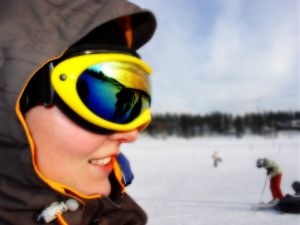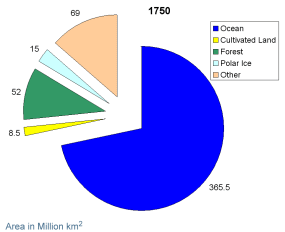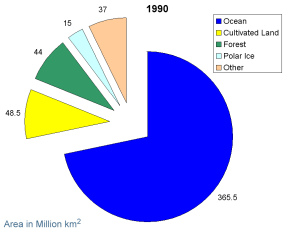 > ACCENT en > Climate Change classes 1 > 3 Albedo
> ACCENT en > Climate Change classes 1 > 3 Albedo
|
|
|
Keywords of this Unit: |
|
The "whiteness" of the Earth The Sun is not particularly strong in winter. It does not reach the top of the sky and it brings less heat. Nevertheless, people doing winter sports have to protect themselves against solar radiation. Their faces can easily get sunburnt even though the air is very cold. Why is this? |
|
Scientists give a name to this ability of surfaces to reflect light. This name is: Albedo. Albedo (latin) means "whiteness". It tells us how white / bright a surface is. |
 |
|
Fig 2: Ice - Desert - Forests - Oceans
|
The "whiteness" in the sky There are days, when the sky is grey and everything seems dark and dim. If we want to take photos, there just isn't enough light. But where has the light gone? If we were to fly by plane above the clouds, the Sun would be shining. The clouds would be looking bright like snow on the top of the cloud layer. This cloud layer does not absorb all the light from the Sun. A major part is simply reflected, similar to snow on the ground. Clouds have an albedo of 40 to 90%, which is much more than the average albedo on the Earth (30%). So, they are much brighter than most surfaces on Earth. Clouds appear bright seen from space, but often make the Earth surface darker and keep sunlight away from us. |
|
|
Global or regional dimming Not everything floating between Earth and sky was made by nature. Some scientists and the media introduced the term "global dimming". What they mean is not a solar eclipse, but the fact that sunlight is at some places rather dimmed when it reaches the Earth's surface. The reasons are not only additional clouds, but primarily a lot of pollution in the air: soot and other particles. Usually this dimming results in a cooling and regionally counteracts global warming. |
|
Aerosol effects But the "dimming" is far from being global. It is most present in regions with strong urbanisation and industry, in which the air is polluted. The particles in the air, called aerosols, partially backscatter the sunlight, before it reaches the Earth's surface. Scientists call this a direct aerosol effect. But particles in the air have also a second effect, an indirect aerosol effect. Since particles are responsible for the formation of cloud droplets, the number of cloud droplets increases, if more particles are present. |
The same amount of water has to be distributed now on more drops. Consequently, there are more smaller droplets instead of fewer large drops. Clouds with smaller droplets are brighter and reflect the sunlight better. Moreover, since the droplets are not large enough for rain, the clouds probably live longer. The interplay of particles in the air and clouds leads to a local cooling. With increasing measures aimed at improving air quality, this effect is diminishing again, as could be observed in the United States and in Europe. In China and many developing countries with less rigid air quality controls, a clear "dimming effect" can still be observed. |
|
|
Loss of snow and ice Since ice and snow strongly reflect the sunlight, reflection is significantly reduced if the area covered by ice and snow becomes smaller. The ground will be darker and take up more solar energy. On a warmer Earth the average snow cover will be lower. However, we do not expect the huge ice masses of Antarctica to melt until 2100. |
 |
|
Fig 6: View of the Arctic Ocean and Antarctica at September, 21st 2005. Towards the end of the arctic summer the extension of sea ice around the North Pole is minimal. At the South Pole, however, the antarctic winter is just ending and the extension of the sea ice around the continent of Antarctica is at its maximum. Visualisation NASA |
|
It can be easily observed by satellites that the sea ice drifting on the Arctic Ocean is strongly decreasing. If the sea becomes warmer, the ice is not only irradiated by the sun, but warmed up from all sides. Ice in warm water is melting faster than in air of the same temperature. Scientists expect that already in a few decades ships will be able to travel in summer via the Arctic Ocean from Europe to East Asia (e.g. Japan and China). This route will be much shorter than the routes used so far. But for our climate, this loss of sea ice also means that the warming accelerates even more since more energy from the Sun is taken up by the dark oceans than by the bright ice. We call this effect a positive feedback. |
|
|
|
How land use makes the Earth brighter Without human interference, natural vegetation would look very different from what we have at present. The image shows a theoretical vegetation map. |
 |
|
Figure 8: Potential distribution of vegetation on our planet Earth if humans did not exist. Source: IPCC AR4, Fig. 2.15 |
|
Already at the beginning of industrialisation, around 1750, about 7.9 – 9.2 million km2 of the Earth's land surface was being used for agriculture or pasture. By 1990, this area had extended to 45.7 – 51.3 million km2 (35-39% of the global land surface). During the same period, about 11 million km2 of forest were lost. This is about the area of Europe. The global forest in 1750 is estimated to have been around 52 million km2; in 1992 it was estimated to be 44 millonen km2 (Ramankutty and Foley, 1999). Since then, further large forest areas have been cut or burnt. |
|
|
|
By the mid 20th century most of the forest in the temperate climate zones had been cut down. At present, deforestation is strongest in the tropics. Since forests have a very low albedo (5-10%), but that of grassland is about 20-25%, the face of the Earth has become lighter due to the conversion from forests to agricultural land. |








